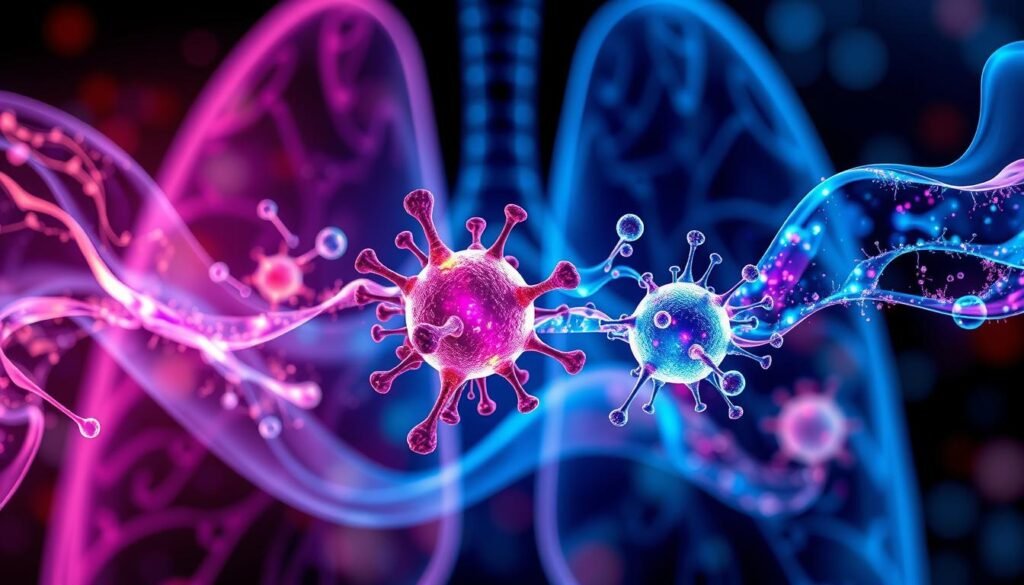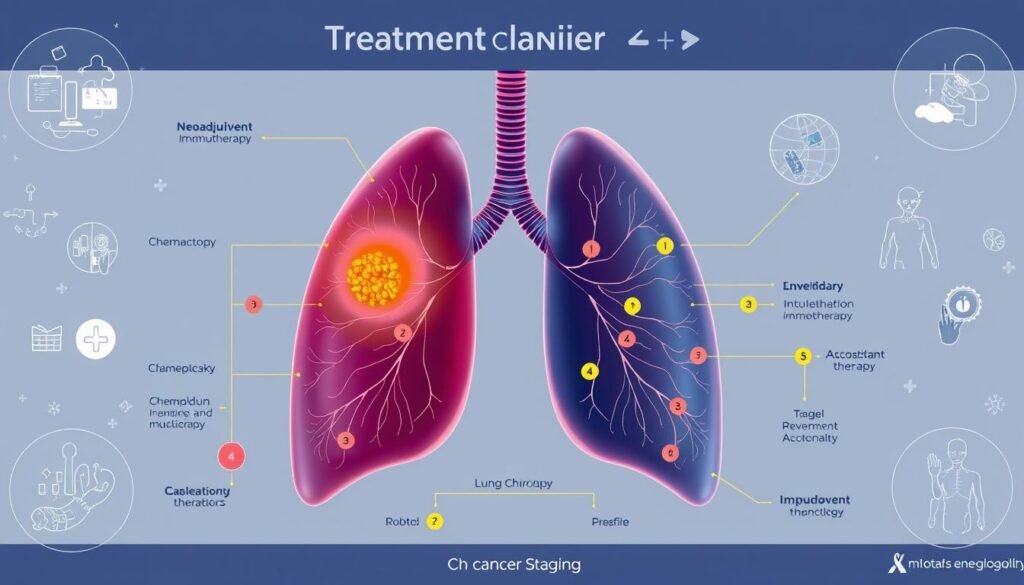Adding nivolumab to chemotherapy has been a big step forward in cancer care. It has led to a 24% pathological complete response (pCR) in patients with operable non-small cell lung cancer (NSCLC). This is a big jump from the 2.2% rate seen with just chemotherapy. This new method is changing how we treat lung cancer, especially before surgery.
The mix of nivolumab with chemo doesn’t just shrink tumors. It also betters the overall results for patients. The CHECKMATE-816 trial showed us this treatment is very effective. It marks a new chapter in our battle against lung cancer. We’re going to look at how this treatment works, its recent successes, and its benefits for people dealing with this tough condition.
Adding immunotherapy to regular chemo is changing the game. There weren’t any big problems with surgery delays or more side effects. This shows it’s a good choice for doctors. For more information on the recent FDA approval, see this source.
Key Takeaways
- Nivolumab combined with chemotherapy shows a pCR rate of 24%, significantly higher than chemotherapy alone.
- The CHECKMATE-816 trial highlights the efficacy of neoadjuvant nivolumab plus chemotherapy.
- Immunotherapy in combination with chemotherapy effectively reduces tumor size before surgery.
- No increase in overall toxicity or delays to surgery was associated with this treatment.
- Overall patient outcomes have improved with the introduction of this innovative treatment strategy.
- The FDA has approved this combination therapy for adults with resectable NSCLC.
Introduction to Lung Cancer Treatment Options
Lung cancer treatment uses many methods. These include surgery, chemotherapy, radiation, and immunotherapy. The choice largely depends on the cancer stage, the patient’s unique needs, and the tumor’s biology. For those with operable non-small cell lung cancer (NSCLC), deciding when and what treatment works best is key.
Neoadjuvant therapy is becoming key in treating lung cancer, especially with nivolumab. This approach combines neoadjuvant therapy with chemotherapy. It aims to shrink the tumor before the main surgery. This can improve surgery outcomes and make it more likely to successfully remove the cancer. This strategy shows a move towards care that is tailored to each patient in surgery.
A study found that 67% of patients faced side effects from treatment, with 33% experiencing severe side effects. Surprisingly, 33% saw their cancer progress in a way that surgery was no longer an option. Among these patients, six could have the tumor surgically removed. This study sheds light on the complicated effects of lung cancer treatment. Of those who had surgery, only two patients saw their cancer completely disappear and stayed cancer-free for more than two years.
Furthermore, the CheckMate-816 trial revealed positive outcomes. It tested combining nivolumab with chemotherapy before surgery. Patients who received this combination did better in terms of event-free survival (EFS) than those who only got chemotherapy. This shows how lung cancer treatment is changing. It also shows the growing importance of neoadjuvant therapy in achieving better results through surgery.
The Role of Neoadjuvant Therapy in Lung Cancer
Neoadjuvant therapy is key in lung cancer care. It treats the cancer before surgery. This approach helps make tumors smaller. This can make surgery easier and less invasive. Patients, especially those receiving new treatments like nivolumab with chemotherapy, often do better.
This method combines immune therapy and chemotherapy. It boosts the effectiveness of the treatment. For example, patients getting nivolumab and chemotherapy can live without cancer growing for about 31.6 months. This is longer than the 20.8 months in those getting only chemotherapy. This shows how important neoadjuvant therapy is in treatment plans.
The rates of patients who see their cancer go away completely are higher with this approach. About 24% of those treated with nivolumab and chemotherapy reach this goal. This is a lot more than the 2.2% with just chemotherapy. These outcomes mark a big change in how we fight lung cancer. They show the value of combining these treatments.
The safety of adding nivolumab to chemotherapy is similar to chemotherapy alone. The serious side effects are about the same. This is good news for those thinking about this treatment. Also, most patients (83.2%) can still have surgery after this combination therapy.
In summary, using neoadjuvant therapy in lung cancer means better survival rates. It also makes surgery less invasive. This improves the overall experience for patients facing lung cancer.
| Treatment Group | Median EFS | pCR Rate | Surgical Feasibility | Grade 3 or 4 Events |
|---|---|---|---|---|
| Nivolumab + Chemotherapy | 31.6 months | 24.0% | 83.2% | 33.5% |
| Chemotherapy Alone | 20.8 months | 2.2% | 75.4% | 36.9% |
Understanding Nivolumab and Its Mechanism of Action
Nivolumab is known by the brand name Opdivo. It is a key player in battling lung cancer. As an immunotherapy agent, it blocks a pathway that cancer cells use to hide from the immune system.
This action strengthens T-cells in the immune system. It helps them find and destroy cancer cells more effectively. By doing this, nivolumab makes a big difference in the fight against cancer.
Nivolumab is also used before surgery for patients with a certain kind of lung cancer called non-small-cell lung cancer (NSCLC). Its goal is to completely remove cancer and to help patients live longer without their cancer getting worse. Studies show that adding nivolumab to chemotherapy can extend the time patients live without cancer progression to 31.6 months from 20.8 months with just chemotherapy.
The combination of nivolumab and chemotherapy has shown to be very effective. About 83% of patients were able to have surgery to remove their cancer with this treatment. This is higher compared to 75% with chemotherapy alone. These results mark a big step forward in treating lung cancer.
This treatment is especially interesting because of how it increases the chances of a major response when the cancer has a lot of PD-L1. When PD-L1 levels are high, up to 80% of patients treated with nivolumab and chemotherapy saw their cancer respond significantly. This highlights the power of this immunotherapy in changing the way we treat lung cancer.
Neoadjuvant Nivolumab Plus Chemotherapy in Resectable Lung Cancer
The CHECKMATE-816 trial is a big step forward in treating resectable lung cancer. It looked at how well early treatment with nivolumab and chemotherapy works for Stage IB to IIIA non-small cell lung cancer. The study had 358 people and aimed to find out how this treatment affects patients.
Overview of the CHECKMATE-816 Clinical Trial
This trial was designed to see if adding nivolumab to usual chemotherapy before surgery could help. Out of all patients, 83.2% could have their cancer surgically removed after this treatment. This shows that combining nivolumab with chemotherapy is a promising approach.
Efficacy Results and Patient Outcomes
The trial’s findings were remarkable. Patients treated with nivolumab and chemotherapy had an event-free survival of 31.6 months. This is much longer than the 20.8 months in those who just got chemotherapy. A whopping 24% had no signs of cancer after treatment, compared to only 2.2% who didn’t get nivolumab.
This shows nivolumab can greatly improve patient outcomes. It increases the chances of getting rid of the cancer completely and helps patients live longer without their cancer getting worse.
Importance of Pathologic Complete Response
Getting a complete response after treatment is key to beating lung cancer. High rates of this response are linked to better survival rates. The chances of achieving this with nivolumab and chemotherapy are much higher. This could mean better surgery results and a greater chance of treatment success for patients.

Benefits of Combining Nivolumab and Chemotherapy
Combining nivolumab with chemotherapy is changing lung cancer care. It helps patients live longer without their disease getting worse and manages side effects better. This approach has made a big difference, offering hope to many people.
Improvement in Event-Free Survival
Studies show that using nivolumab with chemotherapy before surgery increases the time patients live without their cancer worsening. The time jumped from 19.6 months to 30.6 months when nivolumab was added. This 11-month gain is significant. It shows how this combo can help patients more than chemotherapy alone.
Also, the rate of patients seeing no sign of cancer after treatment went up to 30.3% with nivolumab, from 5.7% with just chemotherapy. This big difference proves the combo’s power in fighting lung cancer.
Management of Potential Side Effects
Nivolumab and chemotherapy together may bring side effects like nausea and tiredness. But these are often manageable. Even though there are more severe side effects in some cases, they’re still within a manageable range.
In fact, serious side effects occurred in 59.4% of patients getting both treatments. This is compared to 42.9% with just chemotherapy. Despite this, the side effects can be well managed, following the right strategies. This makes the combined treatment a viable option for many.
| Measure | Nivolumab + Chemotherapy | Chemotherapy Alone |
|---|---|---|
| Median Event-Free Survival (months) | 30.6 | 19.6 |
| Pathological Complete Response Rate (%) | 30.3 | 5.7 |
| Grade 3/4 Treatment-Related Adverse Events (%) | 59.4 | 42.9 |
| Surgery Completion Rate (%) | 93 | 69 |
Current FDA Approval and Clinical Implications
On March 4, 2022, the FDA gave a thumbs up for nivolumab with platinum-doublet chemotherapy for adults with operable non-small cell lung cancer (NSCLC). This marks the first FDA nod for pre-surgery therapy in early-stage NSCLC. It’s a big step in changing how we treat this cancer.
The phase 3 CheckMate-816 trial showed that nivolumab and chemo before surgery cut the death risk by 37% for patients with resectable stage IB to stage IIIA NSCLC. Patients lived without cancer getting worse for 31.6 months with this combo. This is compared to 20.8 months with just chemo. These findings prove nivolumab’s strength in boosting patient survival and surgery success.
Pathologic complete response rates jumped to 24% with nivolumab and chemo. This is much higher compared to just 2.2% with chemo alone. Patients with a complete pathologic response saw over an 80% drop in their cancer coming back. These facts hint at possible longer lives with a hazard ratio of 0.57. It shows the good in adding nivolumab to treatment plans.

With noticeable differences in treatment side effects, nivolumab’s approval is key in bettering resectable NSCLC care. For example, serious treatment side effects happened in 36.9% of the chemo-only group. But it was 33.5% in those also getting nivolumab. More patients getting nivolumab went on to have surgery. This underlines its importance in improving surgical outcomes.
The FDA’s green light for nivolumab spotlights its value in pre-surgery settings and paves the way for more research and treatment options. The medical world is keen on learning more about pre-surgery immune therapy. The outlook for lung cancer care is bright and ever-changing.
Learn more about the FDA approval and clinical implications of nivolumab
The Impact of Immunotherapy on Surgical Oncology
Immunotherapy has changed how we treat lung cancer in surgery. Using nivolumab with chemotherapy before surgery helps patients a lot. It makes lung cancer surgery more effective.
Studies show that nivolumab and chemo together reduce cancer’s return or death by over one-third. This therapy leads to a 24% complete response rate. In contrast, just 2.2% achieve this with chemo alone. Immunotherapy is key in fighting non-small cell lung cancer (NSCLC).
Patients getting both treatments see a 37% lower risk of cancer coming back or death. This was found in 358 lung cancer patients. The combo leads to better results from surgery. It brings benefits like less surgery needed, less blood lost, and quicker surgeries.
In a study, 21 lung cancer patients got nivolumab before surgery. Nine saw their live tumor cells drop by 90% or more. Relapses fell by nearly 40%. This shows how well immunotherapy can work.
However, there are challenges. Some patients face side effects from the treatment. About 67% of patients had issues, highlighting the need for careful treatment plans.
Immunotherapy offers hope beyond just surgery. It helps even those who can’t get rid of cancer completely at first. It’s a major step forwards in lung cancer care. It mixes powerful treatments to better manage the disease.
For more in-depth information about the advancement of immunotherapy in lung cancer treatments, visit here.
Considerations for Cancer Staging and Treatment Planning
Accurate cancer staging is key for effective lung cancer treatment. The introduction of treatments like nivolumab requires changes in staging. This is because patients may respond differently, leading to changes in surgical and treatment decisions.
A study showed a 95% success rate in curative surgery with new treatments. It emphasized the importance of cancer staging and treatment planning. Impressively, those treated with nivolumab had a 100% success rate, and 90% when combined with relatlimab. These results highlight the treatment’s effectiveness and the need for precise cancer staging.
Treatment plans must now consider the growing importance of immunotherapy. Disease-free survival rates were high, with 89% for nivolumab alone and 93% when combined with relatlimab. This supports adding neoadjuvant immunotherapy to treatment plans, improving cancer staging accuracy.
The table below provides key findings from recent studies on nivolumab’s impact on lung cancer:
| Outcome | Nivolumab Only | Nivolumab with Relatlimab |
|---|---|---|
| Pathologically Complete Resection Rate | 100% | 90% |
| 12-Month Event-Free Survival Rate | 89% | 93% |
| 12-Month Overall Survival Rate | 93% | 100% |
| Grade ≥3 Treatment-Emergent Adverse Events | 10% | 13% |
| Surgery Delays Due to Adverse Effects | 4.5% | 3.9% |
Adding neoadjuvant nivolumab to treatment plans means changing how doctors stage cancer. Current research offers insights into treatment effects on surgery outcomes. This encourages a more tailored approach to lung cancer care. For more details, check out the full study here.

Future Research Directions in Lung Cancer Therapy
Lung cancer therapy is rapidly changing. Each year, 2.09 million new cases get diagnosed globally. It’s crucial we keep finding better therapies. Research now focuses on testing nivolumab with chemotherapy and other immune treatments. These could greatly improve how we treat this disease.
Clinical trials are key in finding the best ways to treat lung cancer. They’re looking into the best order for treatments and finding markers to predict treatment success. This will help doctors tailor treatments to each patient’s specific needs.
The success of trials like CheckMate 77T shows why we must include immunotherapy in treatment plans. For patients with a certain type of lung cancer, this could greatly improve their chances. Studies continue to show the importance of understanding how these treatments work for the long term.
Future research will also look at the side effects of new therapies. By understanding these, we can improve patient care during treatment. Working together, cancer research groups are pushing to lower death rates and improve life quality for patients.
New studies are crucial for making lung cancer treatments better. These efforts make the field always advance with the best strategies.
| Statistic | Data |
|---|---|
| Annual Lung Cancer Diagnoses | 2.09 million |
| Annual Lung Cancer Deaths | 1.76 million |
| 5-Year Survival Rate for Stage I NSCLC | Approximately 70% |
| 5-Year Survival Rate for Stage III NSCLC | Less than 30% |
| Main Pathological Remission with Neoadjuvant Immunotherapy | 45% |
| Survival Benefit with Neoadjuvant Chemotherapy | About 5% |
Conclusion
Combining neoadjuvant nivolumab with chemotherapy is a big step forward in treating resectable lung cancer. Clinical trials show major improvements in treatment results, especially in pathologic complete response and event-free survival rates. An impressive 24.0% of patients getting neoadjuvant nivolumab reached a complete response, showing the combination’s strong potential.
In the CHECKMATE-816 trial, patients using nivolumab went a median of 31.6 months without cancer events. This is much longer compared to 20.8 months for those on just chemotherapy. These results highlight the need for more research to boost treatment effectiveness. The safety of this treatment approach is appealing too, as no deaths from treatment were reported in the nivolumab group.
Healthcare providers and patients are now exploring this new treatment option. It’s critical to have informed talks on using neoadjuvant nivolumab plus chemotherapy in planning treatments. This innovative therapy is making strides in lung cancer care and is part of the ongoing fight against this tough disease.